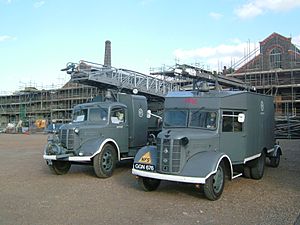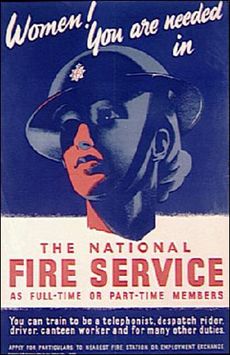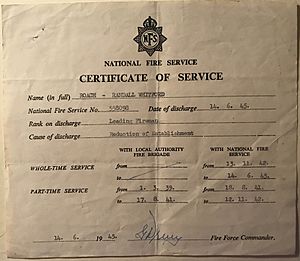National Fire Service facts for kids
The National Fire Service (NFS) was a special fire service created in Great Britain in 1941 during the Second World War. It was formed to protect people and buildings from fires, especially during bombing raids. A separate National Fire Service was also set up in Northern Ireland in 1942.
Before the NFS, there were many small local fire brigades, about 1,600 of them! During the war, it became clear that a single, strong fire service was needed across the country. So, in August 1941, the NFS was formed by combining all these local brigades and the wartime Auxiliary Fire Service (AFS). The NFS worked together until 1948, when fire services went back to being controlled by local areas, but this time there were fewer, larger brigades.
Contents
Who Were the NFS Members?
The National Fire Service had many members, both full-time and part-time, and included both men and women. At its busiest, the NFS had about 370,000 people working for it, including 80,000 women. Women often helped with important office work and other support duties.
NFS members wore a dark blue uniform with a special peaked cap. This cap became a symbol of firefighters and is still used by fire services today.
What Did NFS Members Do?
Being a firefighter during the war was very dangerous. NFS members were called to deal with fires and damage after German bombing raids. Sometimes, they even had to work while attacks were still happening! They showed great bravery, and sadly, some lost their lives while on duty. For example, one young volunteer, just 19 years old, died while working and was given a special award for his courage.
When they weren't fighting fires, many firefighters used their skills to help the war effort. They would work in workshops at their fire stations, making important items needed for the country. This was voluntary, but many had factory skills from before the war, so they were happy to help.
How Was the NFS Organized?
The National Fire Service was a very large organization. It was divided into about forty main groups called Fire Forces. Each Fire Force was then split into smaller sections called Divisions. To make sure everything ran smoothly, each Division had two Columns, and each Column had five Companies. This structure helped them manage firefighters and equipment across the country.
The leader of the entire National Fire Service during the war was Sir Aylmer Firebrace. He was in charge until 1947.
NFS Ranks and Roles
Just like in the police or army, the NFS had different ranks to show who was in charge. Everyone started as a Fireman or Firewoman. As they gained experience and showed leadership, they could move up to ranks like Leading Fireman or Section Leader. Higher up, there were officers like Company Officer, Column Officer, and Divisional Officer. At the very top were the Fire Force Commanders, who led the Fire Forces. This system helped make sure that everyone knew their role and who to report to, which was very important during emergencies.
Famous People in the NFS
Some people who served in the National Fire Service later became well-known, or were already famous:
- Sir Frederick Delve was a career firefighter who later became a very important leader in fire services.
- Leslie Leete was another career firefighter who followed in Sir Frederick Delve's footsteps, becoming a chief officer for the London Fire Brigade.
- Len Johnson was a famous boxer and civil rights activist who served in the NFS in Manchester and Cumbria.
- Paul Brooks was a cricketer who served in London and Coventry.
You can even find an old eleven-minute documentary film from the Second World War that shows how the NFS started and what they did. It's available to watch on the British Pathe website. After their service, members of the NFS received special Certificate of Service documents to recognize their important work.
See also
- 1941 Old Palace School bombing
- Ministry of Civil Aviation Aerodrome Fire Service
- Fire services in the United Kingdom




